Clutch Percentage Value: Complete Guide To Calculation and Significance
Updated On: August 23, 2025 by Aaron Connolly
What Is Clutch Percentage Value?
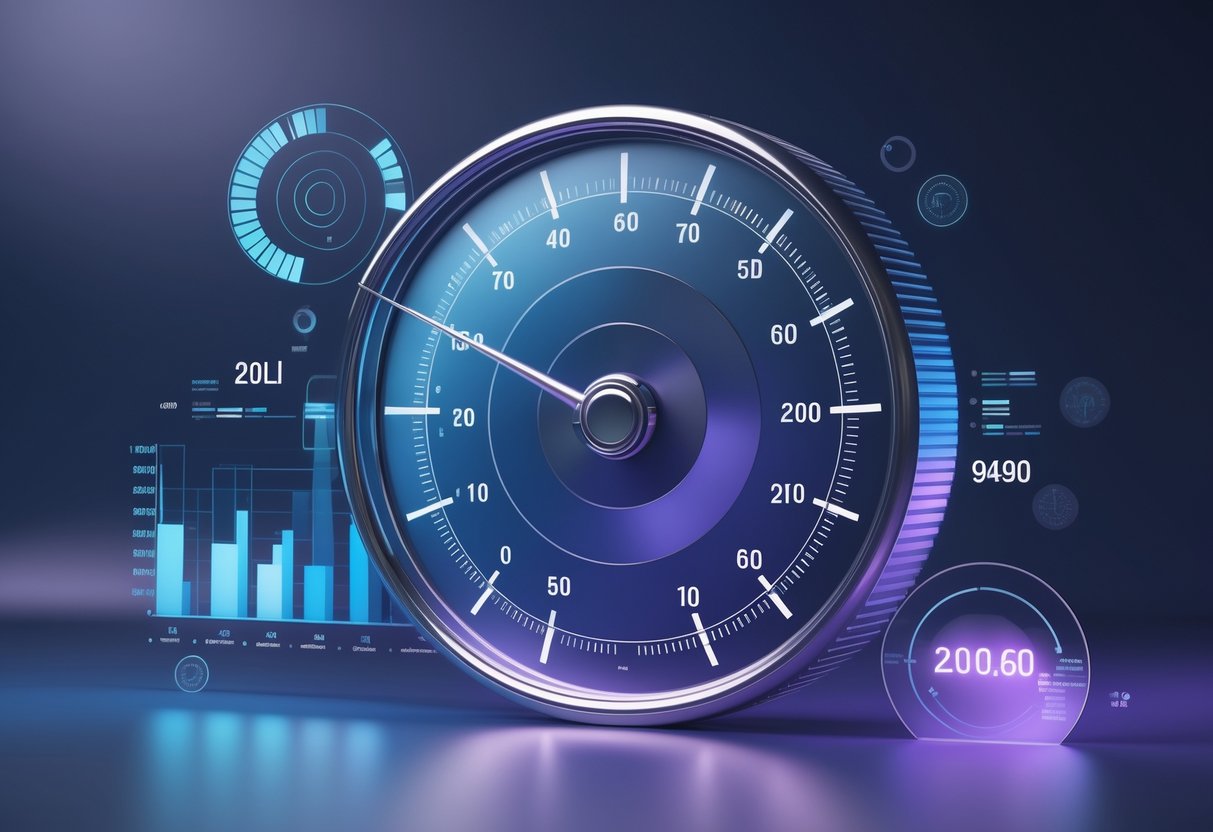
Clutch percentage value tells you how well a player handles high-pressure moments in a match. This stat tracks how often someone turns the odds in their favor when things look bleak.
Definition of Clutch Percentage Value
Clutch percentage value looks at the number of successful clutch situations compared to the total clutch attempts. A clutch moment pops up when a player faces several opponents and their team is almost out.
In most esports games, clutch scenarios mean 1v2, 1v3, or 1v4. The percentage shows how often someone wins these tough encounters.
Key components include:
- How many clutch situations a player faces
- Number of clutch rounds won
- Time pressure
- How important the round is
Games tweak these factors a bit. Counter-Strike and Valorant count clutches in their own ways, but both use percentage calculations.
Purpose and Importance
Clutch percentage gives you a peek at a player’s mental strength and decision-making when it matters most. Teams look at this data to spot players who don’t crack under pressure.
Coaches look at clutch stats for:
- Assigning roles in big rounds
- Checking player confidence
- Deciding what to focus on in training
- Making roster changes
Players with high clutch percentages usually shine in stressful moments. But, let’s be honest, the numbers alone don’t always tell the whole story.
Context really matters. Someone with fewer clutch attempts but a higher success rate might actually be the bigger asset.
Clutch Percentage Value vs. Clutch Wear Percentage
A lot of people mix up these two terms, but they’re worlds apart. Clutch percentage value is about esports performance, while clutch wear percentage deals with car parts.
Clutch percentage value:
- Measures how well you do in games
- Tracks success under pressure
- Goes from 0 to 100%
- Updates after every match
Clutch wear percentage:
- Measures how much a car’s clutch has worn out
- Tracks physical wear and tear
- Tells you when to get maintenance
- You get it from diagnostic tools
We’re sticking with the gaming metric here. The car stuff doesn’t matter for esports stats.
How Clutch Percentage Value Is Calculated
Modern clutch percentage values come from your car’s ECU, which checks how much the clutch has worn out. The system compares the new clutch position to the current worn one, then uses a formula to turn this difference into a percentage.
Diagnostic Readout Methods
You can get clutch percentage values with OBD2 diagnostic scanners. Tools like the Autel MaxiAP AP200, Launch X431 Pro, and Texa systems do the job.
Plug these scanners into your car’s ECU. The computer grabs clutch position data right away. Most scanners just show a simple percentage—something like “45%” or “67%”.
Key scanner features:
- Read where the clutch is right now
- Show the baseline from a new clutch
- Calculate the percentage for you
- Display wear index numbers
Sensors in the ECU keep an eye on clutch position. You get accurate readings without having to take anything apart.
Calculation Formulas
To figure out clutch wear, subtract the current position from the new clutch position. Divide that by the total wear range, then multiply by 100.
Standard calculation: (Current Position – New Position) ÷ Total Wear Range × 100 = Percentage
Ferrari 360s use about 8.5mm as the total range. Ferrari 430s use roughly 5.6mm.
Example:
- New clutch: 20.02mm
- Current: 23.15mm
- Difference: 3.13mm
- Percentage: (3.13 ÷ 5.6) × 100 = 56%
Car makers use different baselines. Always check your model’s numbers.
Key Measurement Parameters
The ECU tracks a few important things for good calculations. Closed clutch position shows exactly where your clutch sits when it’s fully engaged.
Closed clutch position (new) is the measurement from a brand-new clutch. Technicians save this value when they put in new parts.
The clutch wear index helps confirm things. Typical values range from 4,000 to 15,000, depending on your car.
PIS (Position Index Setting) tweaks the clutch engagement point. Technicians can set this between 5.2mm and 5.4mm for better performance.
These numbers work together for accurate wear percentages. The system adjusts for different clutch thicknesses and release bearing travel.
Understanding Clutch Wear
Clutch wear happens as the friction material gets thinner from regular use. This wear changes the clutch percentage value you see on diagnostic tools.
How Clutch Wear Occurs
Every time you push the clutch pedal, you start wearing it out. The friction plates rub the flywheel and pressure plate to disconnect the engine from the transmission.
This rubbing shaves off a bit of material each time. Gear changes create tiny amounts of wear, and over miles, it adds up.
High-performance cars like Ferraris and Maseratis wear out their clutches faster. Their engines make more heat and pressure, which speeds things up.
Usually, the clutch wears from the edges first. The center stays thicker because it gets less pressure. You might spot this uneven wear if you look through inspection ports.
Signs of Clutch Wear
Slipping is the big red flag. If your engine revs but the car doesn’t move as expected, especially uphill, that’s a sign.
You might hear noises too. Some people get a whining sound on cold starts, often from worn release bearings or friction plates touching in ways they shouldn’t.
Gear engagement problems show up as the clutch wears more. The transmission could pop out of gear, or you might feel vibrations through the pedal.
If you check through the inspection port, you’ll see the clutch grooves getting shallow or even gone. Sometimes one side wears down more than the other.
Effects of Wear on Clutch Percentage Value
The clutch percentage shows how much wear has happened compared to new. Most diagnostic tools figure this out by measuring how far the release bearing has moved.
For example: A Ferrari 360 has about 8.5mm of travel from new to worn. The 430 uses 5.6mm. The ECU divides the current wear by the max travel for the percentage.
| Clutch Wear Level | Typical Symptoms | Action Needed |
|---|---|---|
| 0-40% | Normal operation | Just keep an eye on it |
| 40-70% | Might start slipping | Plan for replacement |
| 70-80% | Problems are obvious | Replace soon |
| 80%+ | Severe slipping | Replace right away |
Heads up: Clutch percentage readings can change a bit between diagnostic tools. Mechanics usually recommend changing the clutch around 80% to dodge sudden breakdowns.
Clutch Closed Position and Its Role
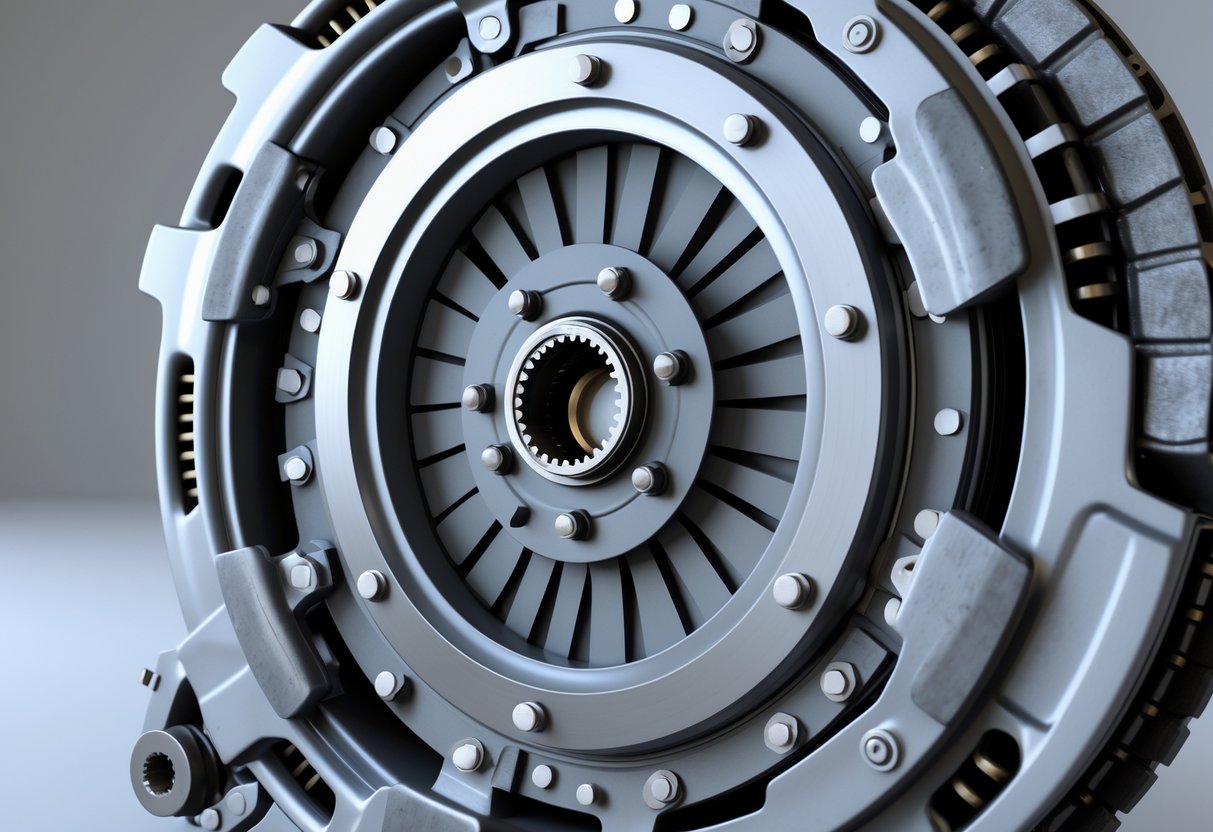
The clutch closed position shows how far the release bearing sits from the flywheel when the clutch is fully engaged. This number matters for clutch wear percentage and helps you know the real state of your clutch.
The Meaning of Closed Position
The closed position tells you the exact gap between the release bearing and flywheel when the clutch plates are pressed together. It’s measured in millimetres.
When the clutch is new, this gap sits in a certain range. Most systems stick to the manufacturer’s baseline numbers.
Sensors in the ECU keep tabs on this position. The system uses the data to make tiny adjustments as the clutch wears.
Self-calibrated closed clutch position means the system updates itself for current wear. You don’t have to do anything.
Closed Position Measurement
Sensors attached to the release bearing or actuator system measure clutch closed position. They send signals to the ECU.
Diagnostic tools can pull this number straight from the car’s computer. You’ll see it in millimetres on the scanner screen.
You measure this when the clutch pedal is fully released. That’s when the clutch plates are all the way together.
Modern F1-style gearboxes do this check automatically every time you start the car. The system compares the reading to the value from when the clutch was new.
Note: Different scanners might show slightly different numbers. Stick with one type to keep things consistent.
Impact on Clutch Percentage Value
Clutch percentage depends a lot on two closed position numbers. Subtract the “new clutch” position from the current “self-calibrated” one.
That difference tells you how much clutch material has worn away. The ECU turns that into a percentage.
When the closed position gets bigger than normal, your clutch percentage goes up. Most systems start having trouble above 90% wear.
A worn clutch pushes the release bearing farther from the flywheel to keep things working. That extra distance means a higher percentage on your scanner.
Interpreting Clutch Percentage Value Readings
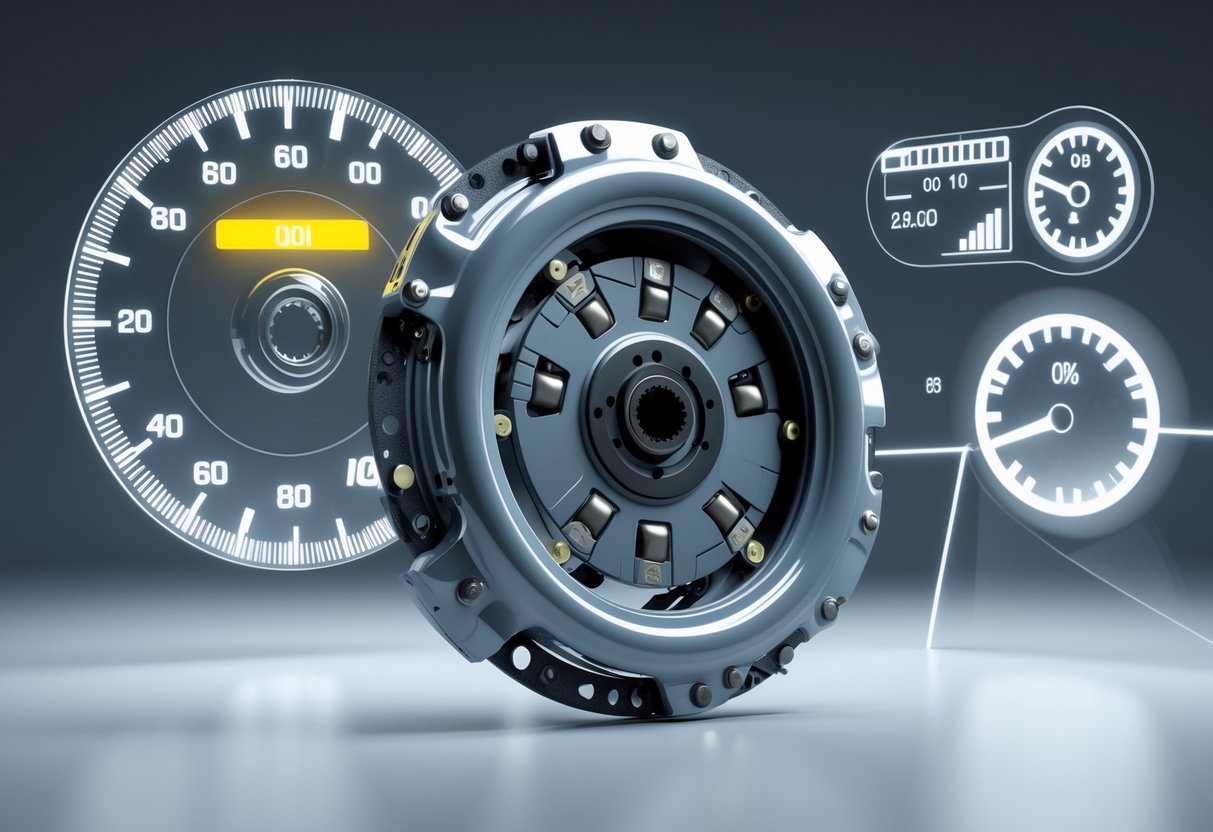
To make sense of clutch percentage readings, you need to know what’s normal and how to spot warning signs. Most tools show clutch wear as a percentage—0% is brand new, 100% is totally worn out.
Typical Value Ranges
A healthy clutch usually sits between 0% and 40% wear. If you just got a new clutch and reset everything, it’ll read 0%.
Cars can run fine up to 60-70% wear. After that, you might notice shifting feels a bit different.
Warning levels kick in around 80-85%. At this point, you might get slipping under heavy load or high revs.
Clutches hitting 90-95% wear often start causing shifting headaches. Ferraris with F1 systems act up above 90%.
Once you hit 95-100%, the clutch is basically done. It can’t grab properly and needs replacing ASAP.
What High or Low Values Indicate
Low values (0-30%) mean your clutch is still pretty fresh. Everything’s working as it should.
Medium values (40-70%) show some wear but nothing too scary. Just keep an eye on it to see how fast it’s wearing.
High values (80%+) mean it’s time to pay attention. You might notice slipping or trouble shifting.
Readings above 90% usually mean the clutch could fail any time. Schedule a replacement soon so you don’t get stranded.
If you see 95-100%, the clutch is toast. Keep driving and you might wreck other parts too.
Examples from Different Vehicles
Ferrari F1 systems give pretty accurate percentage readings if you calibrate them right. For example, a 2005 Ferrari with 21% wear at 12,000 miles looks totally normal.
Maseratis often show both wear percentage and wear degree. If you see 8.96% wear and 64,022 wear degree, that’s low wear.
Lamborghini Gallardo clutches use a different system. If the current position is 19.03mm and the last was 22.75mm, you’re seeing some wear.
Launch X431 tools read clutch data on lots of brands, but aftermarket tools sometimes get the numbers wrong. Double-check that you’re looking at the actual wear percentage, not some other parameter.
Factors Affecting Clutch Percentage Value
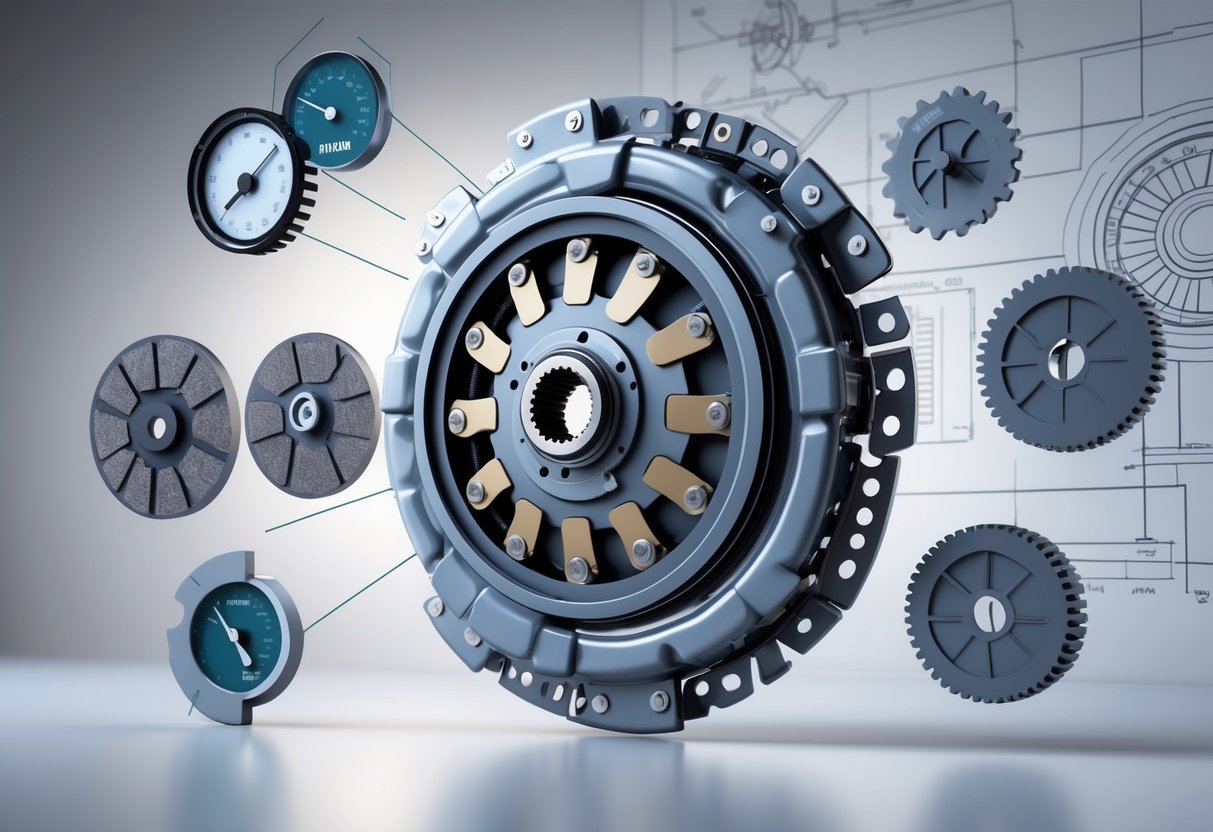
Your clutch percentage value changes depending on your driving style, the type of clutch system in your car, and the specific make and model you drive.
These factors work together to influence how quickly your clutch wears out and when you might need to replace it.
Driving Style
Honestly, how you drive makes the biggest difference in clutch wear. If you’re aggressive behind the wheel, your clutch percentage climbs a lot faster than if you’re gentle.
Some habits are especially rough on clutches—riding the pedal, slipping the clutch on hills, or dealing with constant stop-and-go traffic. Delivery drivers and racers often rack up clutch wear 10-15% faster each year than the average driver.
Mountain driving? That’s tough on clutches too. All those gear changes and hill starts at high revs really speed up the wear.
Traffic jams don’t help either. City drivers end up replacing clutches twice as often as folks who mostly stick to highways.
Every time you engage the clutch in traffic, you add to the wear index. So, it adds up.
If you want your clutch to last, a few habits help:
- Always release the clutch pedal fully after shifting
- Use the handbrake on hills, not the clutch
- Keep your foot off the clutch pedal when you don’t need it
Type of Clutch System
Different clutch systems wear out at different rates, which affects how quickly your clutch percentage value rises.
Most cars use single-plate clutches. These usually need replacement at 80-90% wear, which happens somewhere between 60,000 and 100,000 miles, depending on how you drive.
Performance cars often use dual-clutch systems. Each clutch handles a set of gears, so one might wear out faster than the other—usually the one for lower gears.
Clutch material matters a lot. Organic facings last longer if you drive gently but don’t hold up well under stress. Ceramic clutches can handle more abuse but feel a bit harsh in daily use.
Hydraulic clutches give you a better pedal feel and more consistent engagement, which can help reduce wear from bad driving habits.
Clutch disc size and pressure plate design also play a role. Bigger clutches spread out the load and usually last longer.
Vehicle Make and Model
Every car manufacturer seems to have their own way of designing clutch systems, so wear rates and percentage calculations can vary a lot.
German brands like BMW and Mercedes tend to use sturdy clutches that last over 80,000 miles. Their systems usually calculate wear a bit conservatively.
Performance cars, though, chew through clutches faster. Sports cars with high-torque engines put a lot of stress on the clutch, even in normal driving.
Engine torque has a direct effect. Diesels with high torque figures wear out clutches faster than similar petrol engines.
Vehicle weight matters too. Heavier cars need more clutch slip to get moving, which means more wear. Lightweight city cars often get 100,000 miles or more from their original clutch.
Some manufacturers set their diagnostics to show higher percentage values sooner, nudging you toward preventive maintenance. Others wait until the clutch is nearly done before alerting you.
Transmission type changes things as well. Manuals with close gear ratios make life easier for the clutch, while wide-ratio boxes mean more rev-matching and more wear.
Clutch Life Expectancy and Replacement Thresholds
Most clutches last somewhere between 60,000 and 100,000 miles. If you treat your car well, you might even get 170,000 miles or more.
Knowing when your clutch needs replacing—and sticking to percentage-based maintenance—will save you from expensive breakdowns and keep your performance sharp.
Recognising When Replacement Is Needed
Usually, clutches start showing signs of wear between 50,000 and 80,000 miles.
You might notice it gets tough to engage gears, the clutch pedal feels spongy or sticks, or you hear odd noises when you press the pedal.
Clutch slippage is the big red flag. If you hit the gas and the engine revs but your speed doesn’t match, your clutch is probably slipping.
If you smell something burning while driving, especially in heavy traffic or on hills, your clutch might be overheating and needs checking right away.
Other signs to watch for:
- Grinding sounds when shifting
- Vibrations in the clutch pedal
- The engagement point getting higher than usual
- The clutch pedal not working at all
A good mechanic can measure clutch wear percentage with special tools. Most say you should replace the clutch when there’s only 10-20% thickness left.
Percentage Value Guidelines for Maintenance
It’s smart to keep an eye on clutch wear at certain mileage points.
At 25% wear (about 15,000-25,000 miles), get your clutch checked during routine service.
If you hit 50% wear (roughly 30,000-50,000 miles), start scheduling checks every 5,000 miles. Around this time, you might notice subtle changes in how the clutch feels.
At 75% wear (45,000-75,000 miles), you should plan to replace the clutch within 10,000-15,000 miles. Don’t wait for it to fail completely, or you could damage other transmission parts.
A quick tip: Many garages offer clutch health checks for £30-50, giving you a wear percentage so you can budget ahead.
Most clutches are built to go until 80-85% wear. After that, reliability just drops off a cliff.
Manufacturer Recommendations
Manufacturers all have their own replacement guidelines.
Ford usually says to inspect clutches at 60,000 miles, while Volkswagen recommends 80,000-mile intervals.
Japanese brands like Toyota and Honda often rate their clutches for over 100,000 miles if you drive normally. European cars usually suggest checking between 60,000 and 80,000 miles.
If you drive a heavy-duty or performance car, expect different numbers. Sports cars sometimes need a new clutch as early as 30,000-40,000 miles because of the extra stress.
Warranties usually cover clutch defects, but not regular wear. Typical coverage looks like:
- Standard cars: 60,000 miles
- Commercial vehicles: 40,000 miles
- Performance models: 36,000 miles
Check your service manual for the exact timing—your driving style and conditions can change things a lot.
Diagnostic Tools and Technologies

Modern clutch diagnostics use special tools that tap into your car’s computer. These tools read clutch wear percentages and other values to tell you when it’s time for a replacement.
Common Tools for Measurement
OBD-II scanners are the most basic tools we have for checking clutch wear. They plug into your car’s diagnostic port and read fault codes, but usually can’t get detailed clutch info.
Professional diagnostic software digs deeper. Tools like VCDS (for VAG cars) or brand-specific programs can read clutch wear percentages straight from the transmission control module.
For dual-clutch setups like DSG, you’ll need advanced tools to read Clutch Volume Index (CVI) values. These numbers show how much fluid it takes to engage each clutch pack. If CVI drops below a certain point, you’ve got significant wear.
Some mechanics use pressure gauges and flow meters to check hydraulic systems. Oscilloscopes help diagnose electrical signals from clutch sensors.
Advantages of Diagnostic Software
Diagnostic software gives you precise clutch wear numbers, so you’re not just guessing.
Ferrari F1 systems, for example, flag shifting problems when wear goes past 90%. That heads off failures before they happen.
The software also creates detailed reports. Instead of swapping out the whole clutch, you can pinpoint whether the disc, pressure plate, or hydraulics are the problem.
Real-time monitoring is a big plus. You can watch clutch engagement while driving and spot issues that only happen sometimes.
Most programs let you reset wear counters after a clutch change, so your readings stay accurate. Some even run automatic adaptation after installation.
Potential Limitations
Not every car supports advanced clutch diagnostics. Older models or basic manuals might only give you fault codes, not detailed wear info.
Generic OBD-II scanners often can’t access brand-specific clutch data. You’ll need something like a VCDS cable (about £300), or even pricier dealer software.
Diagnostic readings aren’t always spot-on. If someone forgot to reset the wear counter after the last clutch swap, your numbers could be way off.
Mechanical issues, like cross-leaks or stuck parts, can mess with the readings too.
Reading the data takes practice. Seeing “354% clutch wear” might sound scary, but the scale might be different than you expect. Some systems just use odd measurement methods that can confuse anyone who’s not experienced.
Maintaining Optimal Clutch Performance
Keeping your clutch in good shape means regular upkeep and careful monitoring. If you catch problems early and trust your clutch performance readings, you’ll avoid early wear.
Preservation Techniques
Good maintenance habits go a long way. Check your clutch fluid every month and replace it every 24,000 miles or two years.
A few key steps:
- Don’t ride the clutch pedal
- Pick the right gear to avoid unnecessary strain
- Keep the clutch system clean and free of debris
Resting your foot on the clutch or holding it partially engaged causes extra friction and heat, which wears things out faster.
Heat is the enemy here. Aggressive driving or heavy loads generate extra heat that can warp clutch parts.
Let your car cool down after hard driving. Inspect the clutch regularly so you spot unusual wear early.
Routine Checks and Adjustments
Monthly checks really help. Look out for changes in pedal feel, the engagement point, and fluid levels.
Make sure to check:
- How far the pedal travels and how it feels
- Fluid color and level
- Strange noises when you engage the clutch
- Slipping when you accelerate
The engagement point should stay the same. If the pedal starts feeling weird, you might have internal wear or hydraulic trouble.
Adjustments aren’t always straightforward. Most cars need a pro for proper calibration. DIY tweaks can damage sensitive parts or even void your warranty.
Keep a log of your maintenance. It helps you spot patterns and predict when you’ll need a new clutch.
Importance of Accurate Readings
Accurate clutch data keeps you from getting stranded or shelling out for surprise repairs.
You need to measure:
- Pedal free play
- Hydraulic pressure
- Consistency of the engagement point
- Temperature
Bad readings can lead to bad adjustments, which just speeds up wear. Professional tools give you better numbers than just eyeballing things.
Modern cars often have digital monitoring systems that track clutch performance and warn you if something’s off.
Even if everything feels fine, get a pro to check your clutch once a year. Early detection saves money and headaches down the road.
Common Myths and Misunderstandings

There are plenty of myths about clutch percentage in competitive gaming, and they often lead people to misunderstand their performance stats.
These misconceptions can mess with how players view their progress or make decisions about strategy.
Misconceptions About Percentage Values
A lot of players think higher clutch percentages always mean better performance. That’s not really true.
Someone with 80% clutch success who only goes for easy 1v1s isn’t necessarily better than a player with 60% success in tough 1v3s. Context matters a lot.
New players sometimes chase high percentages by avoiding hard clutch situations. That actually limits their growth and learning.
Sample size and situation matter more than the raw number:
- 5/5 easy clutches (100%) versus 15/20 mixed (75%)
- Late-round advantages versus early-round disadvantages
- Having team support versus being completely alone
Another myth says clutch percentage directly shows your overall impact. Pro analysts know that a player who creates clutch chances through smart positioning can actually help the team more than someone who never ends up in tough spots.
Influence of Aftermarket Parts
Gaming peripherals and equipment swaps can really shake up clutch performance metrics. Still, lots of players overlook these variables when they track progress.
Mouse sensitivity tweaks usually throw off clutch success rates for a bit. It’s probably best to stick with the same settings during any kind of evaluation, just to keep your measurements honest.
Monitor refresh rates and input lag feel different across setups, especially in those tense moments. If you move from a 60Hz to a 144Hz display, you’ll likely notice better clutch performance after a couple of weeks.
Audio gear changes mess with spatial awareness during clutch scenarios. New headsets or drivers might make things confusing at first if you’re used to certain sound cues.
Key equipment factors affecting clutch percentage:
- Mechanical keyboard response times
- Mouse polling rates and DPI settings
- Network connection stability and ping
- Chair height and ergonomic positioning
Impact of Improper Adjustments
Bad game settings and poor calibration can block clutch success, and players often blame themselves instead of their setup.
Crosshair placement settings trip up a lot of people in high-pressure situations. Players who use crosshairs that don’t fit their playstyle show clutch rates that drop by 15-20%.
Audio balance issues can make you miss critical info during clutch attempts. Footstep audio that works for casual play might not cut it for those 1v1 moments.
Field of view settings matter too. If your FOV’s too narrow, you miss what’s happening around you. Go too wide and things start to look weird, which can throw off your aim.
Common adjustment issues:
- Brightness levels hiding enemy positions
- Keybind conflicts causing input delays
- Graphics settings that kill frame consistency
- Voice chat volumes drowning out game audio
Players often change several settings at once. This makes it tough to figure out which tweaks actually help or hurt clutch performance.
Clutch Percentage Value Across Vehicle Types
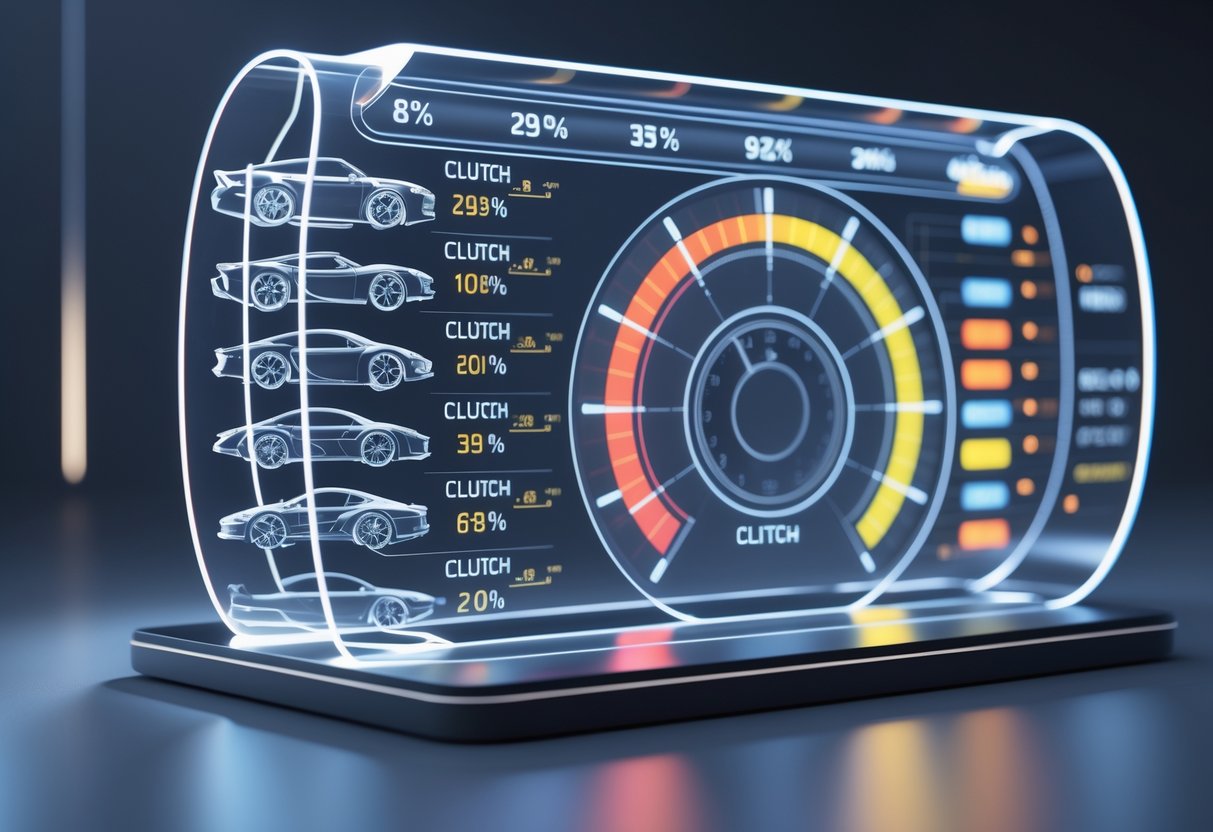
Different vehicles show unique clutch percentage patterns based on their design and transmission systems. Sports cars usually run higher engagement percentages during performance driving. Commercial vehicles, on the other hand, focus more on durability for heavy loads and changing conditions.
Differences in Sports Cars
Sports cars need precise clutch control when pushing the limits. Clutch percentage values typically sit between 85% and 95% during track driving sessions.
Performance cars like the Ferrari 458 or Porsche 911 GT3 use clutches that handle much more torque than standard cars. For track use, it’s smart to pick clutches rated at least 10% above the engine’s max torque output.
Key sports car clutch characteristics:
- Higher engagement percentages during spirited driving
- Faster clutch disc wear rates (you’ll need to replace them around 80% wear)
- More sensitive pedal feel for tight control
Racing clutches often hit a 100% lock ratio during acceleration. Regular road cars usually stay between 70-85% for normal driving.
Sports car telemetry often shows lock ratios above 90% in performance modes.
Variations in Commercial Vehicles
Commercial vehicles work with different clutch percentage needs due to heavy loads and stop-start traffic. Lorries and delivery vans generally show lower average engagement percentages.
Heavy-duty vehicles use clutches rated for 15-25% more torque than passenger cars. Drivetrain losses in these vehicles can eat up about 25% of the engine’s torque.
Commercial vehicle considerations:
- Lower average engagement percentages (60-75%)
- Longer clutch life even with heavy use
- Smooth, progressive engagement for handling loads
Delivery vehicles go through frequent clutch cycles, which changes percentage values compared to highway driving. Commercial clutches tend to hold up across a wider range of percentages.
Fleet operators watch clutch wear closely, usually swapping them out at 75-80% wear instead of waiting for a breakdown.
Relevance for Manual vs. Automated Systems
Manual transmissions directly link clutch pedal input to lock ratio percentages. If the pedal reads 0, the transmission is fully engaged at 100%.
Automated systems use torque converters, so their percentage patterns depend on engine RPM, not the driver. Idle values usually fall between 4-10%.
System-specific differences:
| System Type | Engagement Range | Control Method |
|---|---|---|
| Manual | 0-100% direct | Pedal input |
| Automatic | 4-100% progressive | RPM-based |
| Dual-clutch | 0-100% rapid | Electronic |
Manual friction disc clutches let you partially engage anywhere from 0-100%. Torque converters offer smoother engagement but less precise percentage control.
Automated systems display different slip ratios in telemetry. Blue bar indicators show transmission slip from 0% (fully coupled) to 100% (completely decoupled), which is basically the inverse of lock ratio percentages.
Future Trends in Clutch Wear Measurement

New sensor tech and smarter vehicles are totally changing how we track clutch wear. Now, drivers can see clutch condition in real time instead of just waiting for things to go wrong.
Advancements in Sensor Technology
Modern sensors measure clutch wear way more accurately than before. Temperature sensors track heat buildup during use, which ties directly to wear rates.
Vibration sensors pick up changes in clutch operation that hint at problems. These tiny devices can catch issues weeks before drivers notice anything.
Some sensors now measure the exact position of clutch parts. This helps them figure out how much material has worn away over time.
Torque sensors monitor the force needed to engage the clutch. As friction material wears down, this force shifts in predictable ways.
Researchers have found that these sensors predict clutch failure with over 90% accuracy. They collect data during normal driving and compare it to known wear patterns.
A lot of sensors now connect wirelessly to the car’s computer. That makes installation simpler and keeps the sensors safer.
Integration With Vehicle Monitoring Systems
Vehicle monitoring systems now show clutch wear data right next to engine and brake info. Drivers get a much fuller picture of their car’s health.
Dashboard displays can show clutch wear percentage in real time. Some use color codes—green means good, amber signals wear, and red means it’s time for a new clutch.
Mobile apps let drivers check clutch condition from their phones. These apps can send alerts when wear hits certain levels or suggest when to schedule maintenance.
Fleet operators use these systems to plan maintenance across multiple vehicles. They can get clutches replaced before anything fails and avoid expensive breakdowns.
Predictive algorithms look at driving patterns to estimate how much clutch life is left. They factor in things like city versus highway driving, load weight, and driving style.
Some systems even tweak clutch operation automatically to slow down wear. They might adjust engagement timing or force depending on current driving conditions.
Frequently Asked Questions

Basketball fans love to argue about clutch stats and which players step up when it matters. Here are some questions about the most statistically dominant clutch performers in NBA history and what actually makes certain players thrive under pressure.
Who are the top 10 most statistically clutch players in NBA history?
Michael Jordan tops most clutch lists with a 33.2% field goal percentage in the final moments. Kobe Bryant sits close behind at 25.2% in clutch situations.
LeBron James lands third with some strong clutch numbers over his career. Larry Bird and Magic Johnson round out the top five for clutch performance.
Damian Lillard, who’s nailed plenty of game-winners lately, also makes the list. Kevin Durant usually shoots above 40% in clutch time, which is pretty wild.
How do the clutch shot percentages of LeBron and Michael Jordan compare?
Jordan hit 33.2% on clutch shots, making 25 in playoff elimination games. LeBron has a 32.9% clutch shooting percentage in similar situations.
Jordan took more clutch shots per game during his prime. LeBron has more total attempts because his career’s lasted longer.
Both are about even in accuracy during the last five minutes of close games. Jordan does have a slight edge in game-winners.
Which NBA player has scored the most clutch points in the 2025 season?
This season, several players are battling for the clutch scoring crown. Damian Lillard is usually near the top every year.
Jayson Tatum has become a steady clutch performer lately. Luka Dončić is also putting up big clutch numbers.
Kevin Durant still gets it done in tight spots, even as he ages. These guys just keep delivering in crunch time.
How can one determine the clutch player of the year in the NBA?
Clutch performance gets tracked by shooting percentage in the last five minutes of close games. Game-winners count for a lot in the rankings.
Clutch points scored during the season matter, too. Assists and big defensive plays in key moments add to a player’s clutch value.
Playoff clutch stats usually carry more weight than regular season numbers. Advanced stats like clutch win probability added also help show who made the biggest impact.
What are the definitive characteristics that make an NBA player clutch in playoffs?
Mental toughness under pressure really sets clutch playoff players apart. They keep shooting accuracy high when it counts most.
Experience in big moments helps them stay cool when everything’s on the line. The confidence to take and make tough shots is huge.
Clutch players can create their own shot when they need to. Leadership matters, too—it inspires teammates during those high-stress moments.
Who holds the record for the highest all-time clutch shot percentage in the NBA?
Steve Kerr actually owns the highest clutch shooting percentage among players who took a decent number of shots. He just seemed to thrive under pressure—his consistency in big moments was tough to match.
Reggie Miller pops up near the top too when you look at clutch shooting stats. Both guys knew how to pick their spots when it mattered most.
Minimum attempt requirements really shake up these rankings, depending on which stats you check. Some players with only a handful of attempts end up with eye-popping percentages, but that doesn’t always tell the full story.

